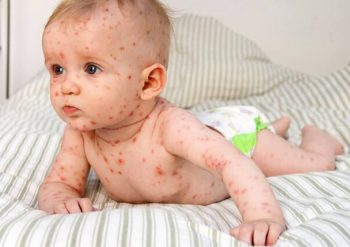As a parent, it can be concerning to see a rash on your child’s skin. While some rashes are cause for alarm, others are simply the result of a virus. In this blog post, we will discuss what causes viral rashes in children and what you should do if your child has one.
Viral Rash Causes
According to the American Academy of Pediatrics, viral rashes happen when a virus enters the body and triggers an immune system response. This response is what causes the rash to appear on the skin.

The most common viruses that cause these types of rashes include measles, chicken pox, roseola, hand-foot-mouth disease, fifth disease (also known as parvovirus B19), and rubella. It’s important to note that not all viruses cause a rash; many times they just cause flu-like symptoms such as fever and body aches.
What To Look For In A Viral Rash
When trying to determine if your child has a viral rash or something more serious, it’s important to look for certain characteristics in the rash itself. Viral rashes tend to start out as small red dots that eventually spread throughout the body. The rash may also become raised or bumpy over time.
Additionally, viral rashes usually don’t itch but may feel hot or irritated when touched. If you suspect your child has a viral rash, contact your pediatrician for further evaluation and guidance on proper treatment options.
When To Seek Medical Attention
In general, most viral rashes clear up without any medical intervention within 7-10 days; however, there are certain signs that warrant immediate medical attention such as high fever (102°F or higher) accompanied by lethargy or vomiting which could indicate something more serious than just a virus at play – like meningitis or sepsis – so it is important to contact your pediatrician right away if you observe these symptoms in conjunction with the rash on your child’s skin.
Additionally, if you notice any discoloration around the eyes or difficulty breathing associated with the rash then make sure you seek medical attention right away as this could be an indication of Kawasaki Disease – a rare but serious condition that requires quick recognition and treatment by healthcare professionals to reduce potential long-term complications such as heart damage or stroke in children affected by it.
Conclusion:
While most childhood rashes are nothing more than an inconvenient side effect of a virus, they can also be indicative of something more serious; therefore it is important to understand how to identify them properly so that you can decide when it is appropriate to seek medical attention for your child’s symptoms right away instead of waiting for them to pass on their own accord.
Luckily there are plenty of resources available online (including our website) where parents can find information about common childhood illnesses and conditions along with advice from experienced physicians about how best treat them – so make sure you take advantage of these resources whenever you need help understanding what might be going on with your little one’s health!


